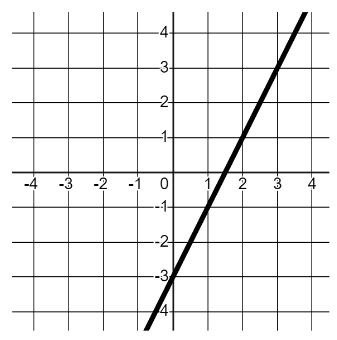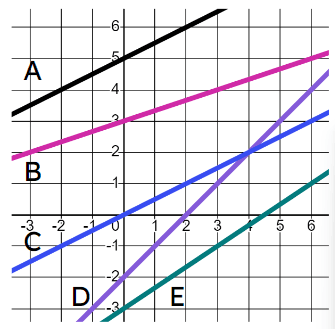Myths about teaching can hold you back


- Year 10•
- Higher
Parallel linear graphs
I can identify, from their equations or graphs, whether two lines are parallel.


- Year 10•
- Higher
Parallel linear graphs
I can identify, from their equations or graphs, whether two lines are parallel.
These resources were made for remote use during the pandemic, not classroom teaching.
Switch to our new teaching resources now - designed by teachers and leading subject experts, and tested in classrooms.
Lesson details
Key learning points
- Two lines are parallel if they are equidistant and never touch.
- For linear graphs, the rate of change is constant.
- If the gradients are the same then the linear graphs may be parallel.
- The y-intercepts must be different, otherwise the lines are the same.
Keywords
Gradient - The gradient is a measure of how steep a line is. It is calculated by finding the rate of change in the y-direction with respect to the positive x-direction.
Intercept - An intercept is the coordinate where a line or curve meets a given axis.
Parallel - Two lines are parallel if they are straight lines that are always the same (non-zero) distance apart.
Common misconception
Lines are parallel if they have the same gradient.
Lines are parallel if they have the same gradient and different y-intercepts. Two lines are parallel if they are straight lines that are always the same non-zero distance apart.
To help you plan your year 10 maths lesson on: Parallel linear graphs, download all teaching resources for free and adapt to suit your pupils' needs...
To help you plan your year 10 maths lesson on: Parallel linear graphs, download all teaching resources for free and adapt to suit your pupils' needs.
The starter quiz will activate and check your pupils' prior knowledge, with versions available both with and without answers in PDF format.
We use learning cycles to break down learning into key concepts or ideas linked to the learning outcome. Each learning cycle features explanations with checks for understanding and practice tasks with feedback. All of this is found in our slide decks, ready for you to download and edit. The practice tasks are also available as printable worksheets and some lessons have additional materials with extra material you might need for teaching the lesson.
The assessment exit quiz will test your pupils' understanding of the key learning points.
Our video is a tool for planning, showing how other teachers might teach the lesson, offering helpful tips, modelled explanations and inspiration for your own delivery in the classroom. Plus, you can set it as homework or revision for pupils and keep their learning on track by sharing an online pupil version of this lesson.
Explore more key stage 4 maths lessons from the Linear graphs unit, dive into the full secondary maths curriculum, or learn more about lesson planning.

Licence
Prior knowledge starter quiz
6 Questions
Q1.Which of these best completes the definition of parallel: 'Two lines are parallel if they are straight lines which...'?
Q2.Match the equation of each straight line to its gradient.
$$y = 5x + 6$$ -
gradient is 5
$$y = 6x + 3$$ -
gradient is 6
$$y = 3 - 5x$$ -
gradient is -5
$$y = -(6 + 3x)$$ -
gradient is -3
$$y + 6x = 5$$ -
gradient is -6
$$2y = 6x + 5$$ -
gradient is 3
Q3.The gradient of the line shown on this graph is .

Q4.Which of these coordinates are on the line $$y = -x - 5$$ ?
Q5.What is the gradient of the line with equation $$3y + 4x - 8 = 0$$ ?
Q6.A line passes through the points with coordinates (-3, 4) and (5, -12). The gradient of this line is .
Assessment exit quiz
6 Questions
Q1.Five lines have been drawn on the same graph. Which of these lines is parallel to line A (black)?

Q2.Match each equation of a line to an equation of a line that is parallel to it.
$$y = x + 4$$ -
$$y = x + 100$$
$$ y = 2x - 3$$ -
$$ y = 2x + 0.5$$
$$ y = 3 - x $$ -
$$ y = -x + {5\over 2}$$
$$ y = 3x - 1$$ -
$$ y = 4 + 3x$$
$$ y = -2x + 1$$ -
$$ y = 3 - 2x$$

